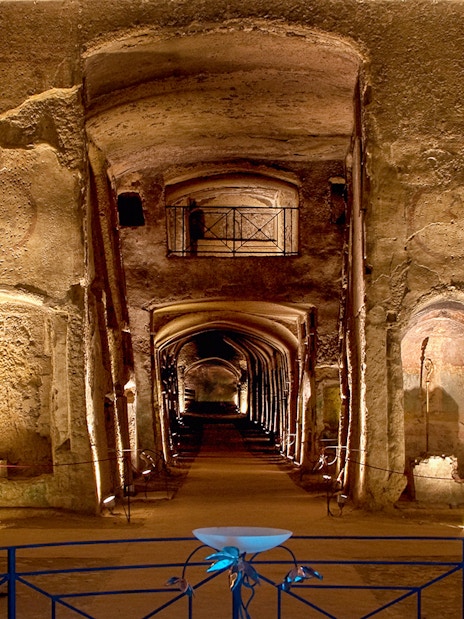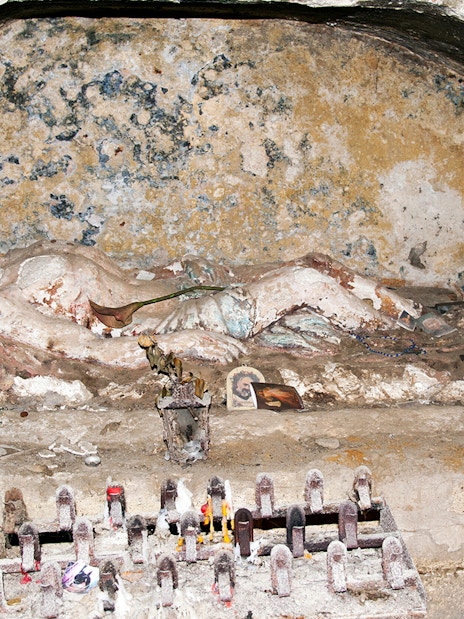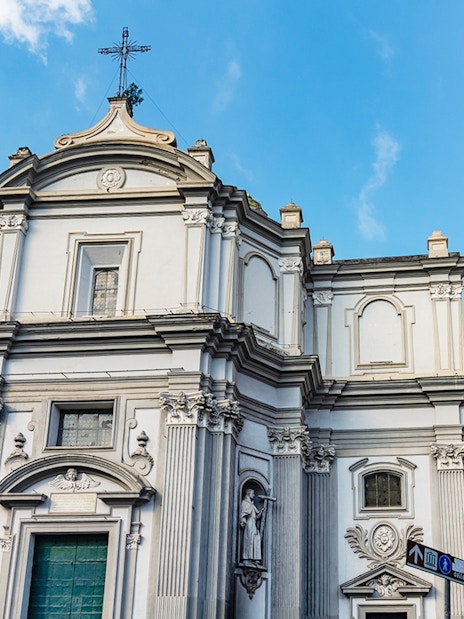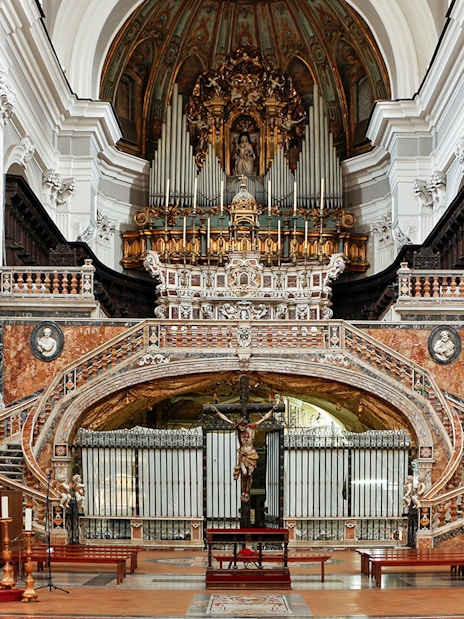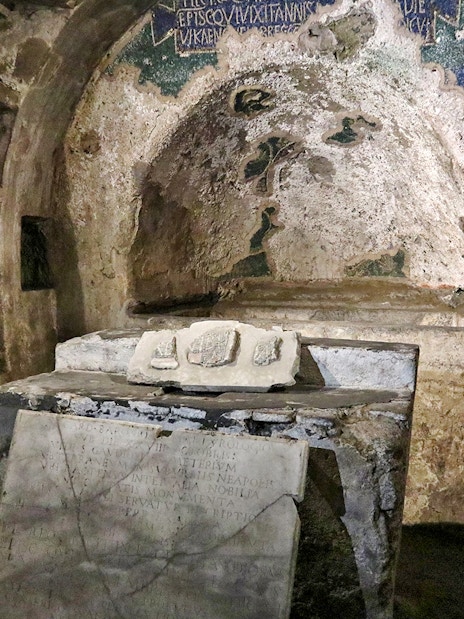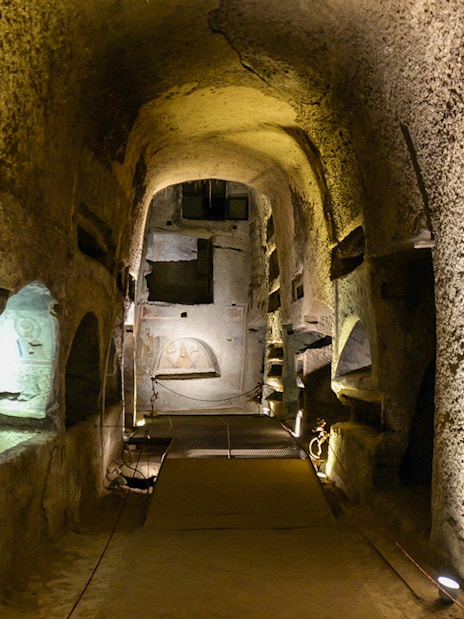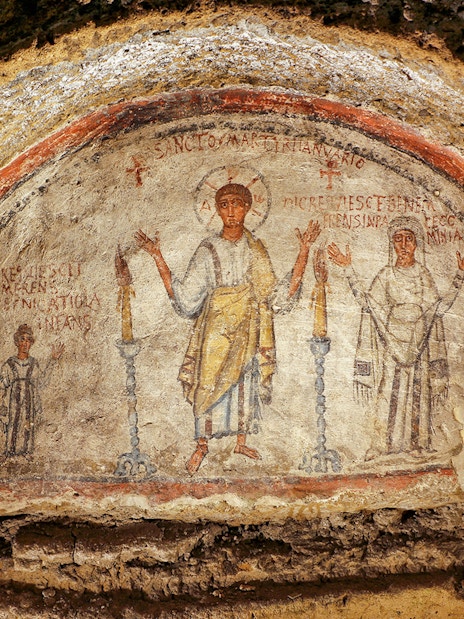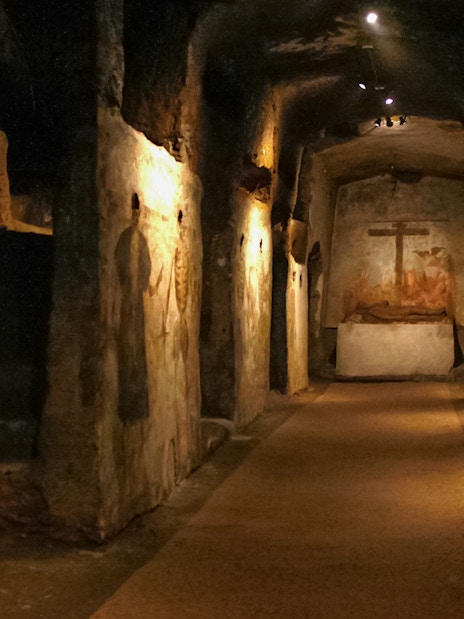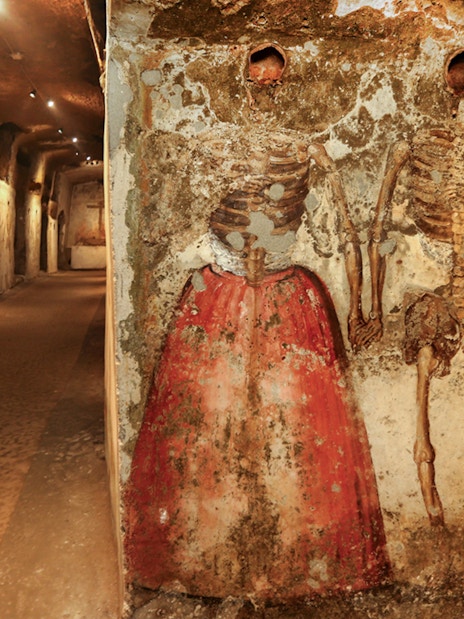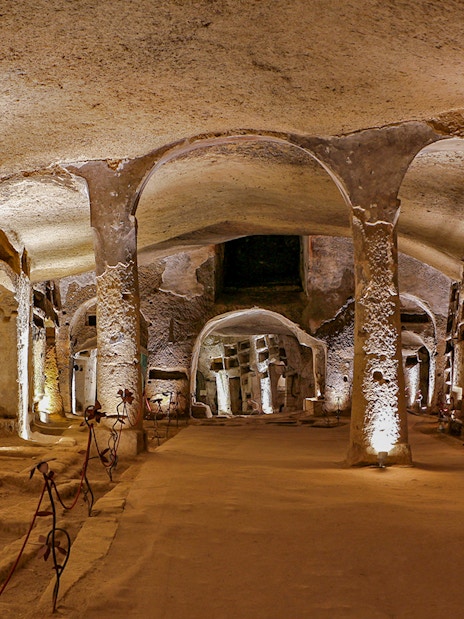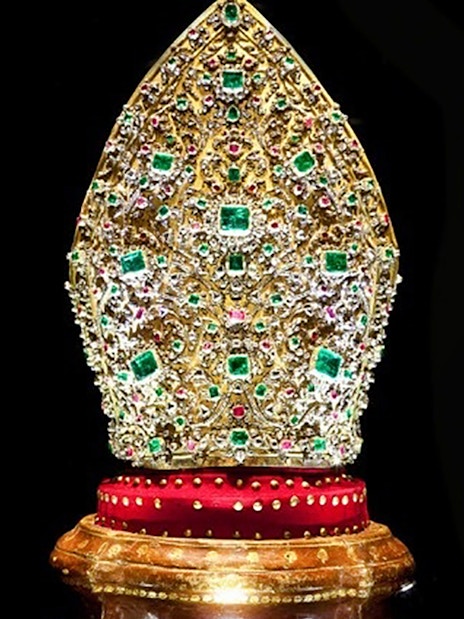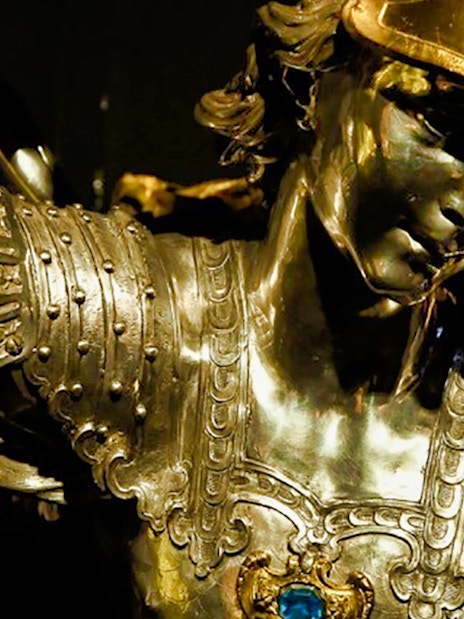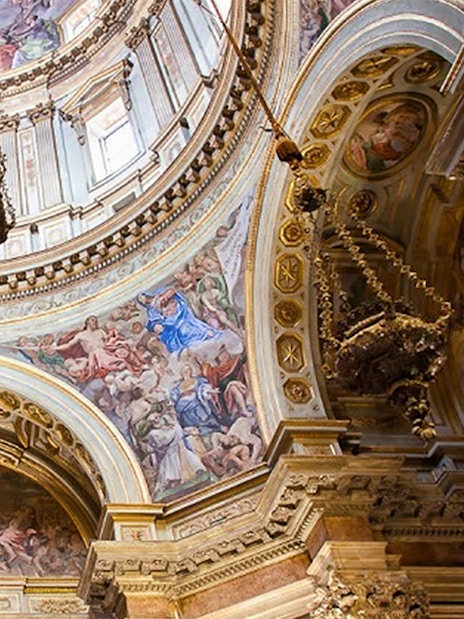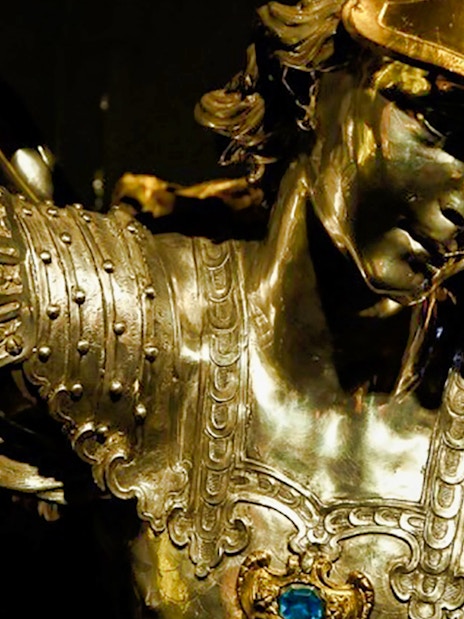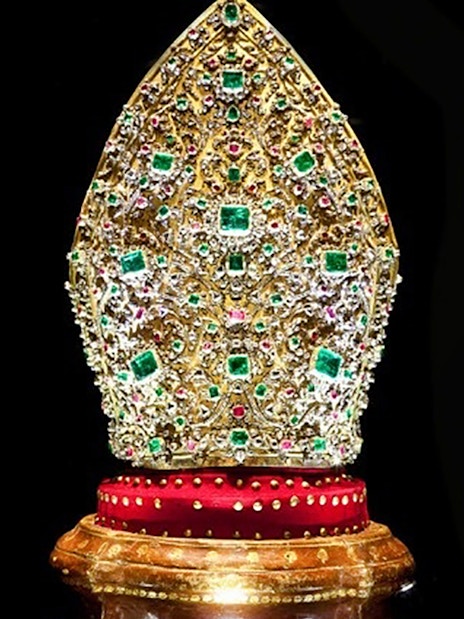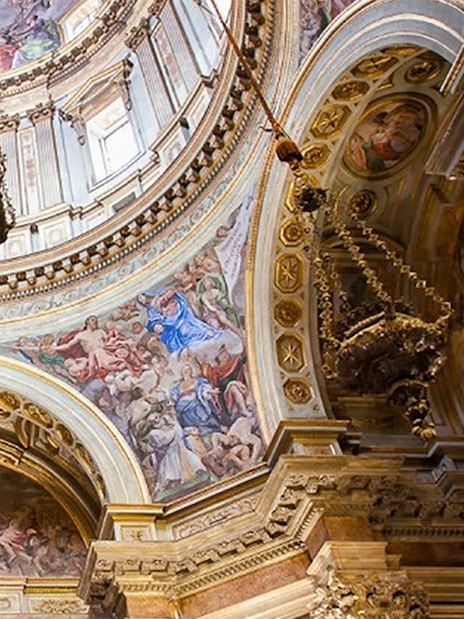- Pompeii Tickets & Tours
- Herculaneum Tickets
- Mount Vesuvius
- Naples National Archaeological Museum
- Museo Di Capodimonte
- Villa Pignatelli
- Royal Palace of Naples
- Certosa di San Martino
- Catacombs of San Gennaro, Naples Tickets
- Capri Boat Tours
- Bourbon Tunnel
- Naples Underground
- Maradona Tours
- Artecard Naples City Pass
- Veiled Christ
- Alibus Airport Transfers
- Naples to Amalfi Coast Tours
- Castel Sant'Elmo
Book Catacombs of San Gaudioso Tickets & Tours
Headout is an authorized and trusted partner of the venue, offering curated experiences to enjoy this attraction. This is not the venue's website.
Flexible entry to Naples' largest Christian burial sites with an expert guide.
- Do it your way. Visit San Gennaro first with a 1-hour guided tour, and San Gaudioso next within 12 months – or vice versa.
- At the Catacombs of San Gaudioso, see early mosaics like Christ Pantocrator and learn about morbid 17th-century burial processes.
- At the Catacombs of San Gennaro, explore grand crypts, basilicas, and the tombs of Naples' patron saint and bishops.
- Admire intricate frescoes and Byzantine paintings from the 9th and 10th centuries, and a baptismal font commissioned by Bishop Paul II.
Flexible entry to Naples' largest Christian burial sites with an expert guide.
- Do it your way. Visit San Gennaro first with a 1-hour guided tour, and San Gaudioso next within 12 months – or vice versa.
- At the Catacombs of San Gaudioso, see early mosaics like Christ Pantocrator and learn about morbid 17th-century burial processes.
- At the Catacombs of San Gennaro, explore grand crypts, basilicas, and the tombs of Naples' patron saint and bishops.
- Admire intricate frescoes and Byzantine paintings from the 9th and 10th centuries, and a baptismal font commissioned by Bishop Paul II.
Inclusions
- 1-hour guided tour of the San Gaudioso Catacombs with entry
- 1-hour guided tour of the San Gennaro Catacombs with entry
- Entry to Basilica di Santa Maria della Sanità
- Expert English or Italian-speaking guide
- While the Catacombs of San Gennaro are partially accessible, the Catacombs of San Gaudioso are not accessible by wheelchair.
- Street level access to the Catacombs of San Gennaro is in Vicoletto S. Gennaro dei Poveri, 22.
- You can cancel these tickets up to 24 hours before the experience begins and get a full refund.
Access the Royal Chapel of the Treasure and learn about the city's patron Saint Gennaro.
- Skip past ticket lines and get time to explore this Baroque gem and centuries-old destination of worship.
- Immerse yourself in a memorable storytelling experience with a 30-minute audio guide available in 5 languages.
- Wander amidst chapels and altars elaborately decorated with gorgeous paintings, frescoes, bronze relics, and silver sculptures.
Access the Royal Chapel of the Treasure and learn about the city's patron Saint Gennaro.
- Skip past ticket lines and get time to explore this Baroque gem and centuries-old destination of worship.
- Immerse yourself in a memorable storytelling experience with a 30-minute audio guide available in 5 languages.
- Wander amidst chapels and altars elaborately decorated with gorgeous paintings, frescoes, bronze relics, and silver sculptures.
Inclusions
- Entry to the Chapel of the Treasure of San Gennaro
- Official audio guide in 5 languages
- This experience is wheelchair and pram/stroller accessible.
- You can cancel these tickets up to 24 hours before the experience begins and get a full refund.
With an expert guide, discover the treasures of San Gennaro at the Royal Chapel and Museum.
- Explore the art and culture unique to Italy with an expert English-speaking guide. Visit the Cappella del Tesoro, a place that symbolizes art and devotion.
- Take a close look at rare items in the Museum of Treasures accumulated over 7 centuries, with the largest collection of silverware in the world!
- Find a variety of manuscripts and registers – up to 6,000 dossiers and 320 books. Uncover the tales of these cultural and historic sites.
- Admire art collections dating back to the 16th and 17th centuries in the Cathedral of Naples.
With an expert guide, discover the treasures of San Gennaro at the Royal Chapel and Museum.
- Explore the art and culture unique to Italy with an expert English-speaking guide. Visit the Cappella del Tesoro, a place that symbolizes art and devotion.
- Take a close look at rare items in the Museum of Treasures accumulated over 7 centuries, with the largest collection of silverware in the world!
- Find a variety of manuscripts and registers – up to 6,000 dossiers and 320 books. Uncover the tales of these cultural and historic sites.
- Admire art collections dating back to the 16th and 17th centuries in the Cathedral of Naples.
Inclusions
- Entrance to the Chapel of San Gennaro
- Entrance to the San Gennaro Museum
- Live guide
- 90-minute tour with an expert guide
- Tip: Don't forget to carry your cameras to capture the mesmerizing Baroque architecture and the jewels you will see on this guided tour.
- You can cancel these tickets up to 24 hours before the experience begins and get a full refund.
Top things to do in Naples
Why visit the Catacombs of San Gaudioso?

✝️See Christian artifacts and treasures
Inside the catacombs, visitors can find a rich collection of splendid frescoes that illustrate both biblical scenes and images of early Christian life, epitaphs, and crypts. The main characteristic of this place is a fresco representing the Madonna della Sanità and is the oldest picture of Maria in the Campania region.
☠️Discover rare Renaissance burial art
The Catacombs of San Gaudioso uniquely blend early Christian traditions with Baroque artistry. Admire skull-and-bones frescoes paired with painted skeletons, a striking form of funerary art that reflects the era's fascination with mortality and the afterlife.
🪦Explore the Tomb of San Gaudioso
This catacomb is named after Saint Gaudiosus, a North African bishop who fled to Naples in the 5th century. His tomb remains a focal point, surrounded by early Christian mosaics and inscriptions that narrate his life and legacy.
🩻Witness Naples’ unique ‘draining’ burial method
Unlike other burial traditions, the catacombs showcase the scolatoi, a fascinating method where bodies were drained of fluids before interment. An exclusive practice that provides insight into the city’s macabre customs.
Your Catacombs tickets explained
Explore the Catacombs of San Gaudioso

The Fresco of Pascentius
One of the most ancient frescos in the Catacombs of San Gaudioso, this dates back to the 5th or 6th century and represents a welcome scene. Its center depicts the figure of the Apostle Peter, introducing the deceased Pascentius to an unknown figure, either Christ or probably St. Paul. Another striking element is the presence of two candlesticks with burning candles placed on either side of the figure, resembling African representations.

The Fresco of Madonna
The San Gaudioso Catacombs were confirmed as a burial site in the 16th century, after the discovery of the Madonna fresco that had been previously concealed by mud. The Madonna della Sanita dates back to the 5th-6th century and is the oldest depiction of the Virgin Mary in the Campania region. After the revelation of this fresco, the catacombs were entrusted to the Dominicans, who later built the Basilica so as to house them in the building.

Tombs of the 17th century noblemen
During the 17th century, the catacombs housed graves of the nobility, mostly the aristocrats and the clergy. The tombs of these noblemen were created in a unique procedure where the skulls were placed on display in the ambulatory walls, while the rest of the corpse was frescoed. This mostly included clothes and occupational instruments that symbolized the social status of the deceased. Interesting fact; these frescoes were created by an artist, Giovanni Balducci, who refused payment in exchange for securing a place among the aristocrats after his demise.
Distance between the Catacombs of San Gennaro and the Royal Chapel of the Treasure
Distance between the Catacombs of San Gennaro and the Catacombs of San Gaudioso
Plan your visit to the Catacombs of San Gaudioso

- Opening hours: 9:30am to 5pm, Thursday to Tuesday
- Closed On: Wednesday, December 25, January 1
- Last entry: 5pm
- Best time to visit: Plan your visit to San Gaudioso during the quieter low season, between November and February. For the best experience, steer clear of weekends and public holidays, and aim to go early in the morning or after 4pm.

- Address: Via Sanità, 123, 80136 Napoli NA, Italy Find on Map
- By metro: Line 1, Line 2
Nearest stop: Museo station, Cavour station - By bus: Take bus lines 168, 178, C63, or R4 from the Museo Nazionale stop
Nearest stop: Basilica Incoronata - Catacombe San Gennaro - By car: Take the Tangenziale (beltline) to the Capodimonte exit (number 5) and turn right onto Via Capodimonte. San Gaudioso Catacombs is 7 min away from Capodimonte Museum.
Parking facility: There is free parking for visitors.

- Relief plaques for easy navigation for visitors with visual impairments
- Free parking facilities
- Audio guides available, need to be bought separately

- The Catacombs of San Gaudioso are free from architectural barriers, however, due to hydrogeological instability, people with restricted mobility will find it not accessible
- Embossed plaques along the itinerary offer a seamless visit for the visually impaired
- The catacombs are not accessible by wheelchairs
- Accessible by strollers

- Starita: A classic Neapolitan pizzeria, famous for its Angioletti Fritti, 3 min away
- Cantina del Gallo: Oldest restaurant and pizzeria with more than 100 years of history, 2 min away
- Poppella: A popular pastry shop ideal for quick grab & bite, 1 min away
- Da Concettina a Tre Santi: Famous woodfire pizzeria with gourmet toppings, 2 min away
- Pizzeria La Campagnola: Local favorite joint for pizzas, pastas & spaghetti, 9 min away

- Carrying large backpacks and trolleys is prohibited
- Smoking or consumption of drugs (except prescribed medication) is strictly prohibited
- Make sure to reach the catacombs at your selected timeslot, don’t risk missing your tour!
- Using flashguns for photography is not allowed

- Catacombs of San Gennaro: Underground burial chambers for Paleo-Christians and site of worship, 12 min away
- Museum of Capodimonte: A treasure trove of Neapolitan art & paintings, ancient Roman sculptures, 7 min away
- Naples National Archaeological Museum: Houses ancient Roman remains and artifacts from Roman, Greek, and Renaissance times, 10 min away
- Sansevero Chapel Museum: A hidden gem of international artistic heritage, 7 min away
- Piazza del Plebiscito: Largest landmark square in Naples, home to the neo-classical Royal Palace, 12 min away

- Wear comfortable shoes and a light sweater or jacket as temperatures below ground remain at a cool 15 degrees Celsius even in summer
- Dress modestly as it is a holy place for Christians; wear knee-length dresses, and avoid putting on sleeveless outfits
- Visitors with cardiac conditions can avoid visiting San Gaudioso Catacombs as they might feel claustrophobic
- Visitors must have a moderate physical fitness level
Frequently asked questions about the Catacombs of San Gaudioso
The Catacombs of San Gaudioso, in Naples, are underground Christian burial chambers, dating back to the 4th or 5th century. The site contains remains of St. Gaudiosus and other members of the nobility.
The Catacombs of San Gaudioso is the second largest in Naples after those of San Gennaro, home to beautiful frescoes and mosaics from the 5th and 6th centuries that depict early Christian symbols. In the 1600s, the catacombs became an important burial site for Naples' noble and aristocratic families. During your visit, you can discover several Neapolitan traditions and folklore around the cult of the dead and the afterlife.
You can book the Catacombs of San Gaudioso tour online. This way you can book your preferred slot, plan in advance and eliminate the hassles of buying tickets from the venue in queues.
No, catacombs require an expert guide to help you navigate through the labyrinth of tunnels, ensure your safety and provide you with valuable information about the historical significance of the Catacombs of San Gaudioso.
Yes, you can book guided tours of San Gaudioso Catacombs online and explore the ancient subterranean crypt, under the guidance of an English-Italian-speaking guide.
Booking a combo tour allows you to explore the San Gaudioso Catacombs along with free access to the San Gennaro Catacombs and the Basilica of Santa Maria della Sanita. It also includes a discounted entrance to the Cloister of Santa Chiara.
A guided tour of the Catacombs of San Gaudioso will cost you €11.
The San Gaudioso Catacombs are located in Via Sanità, 123, 80136 Napoli NA, Italy.
Yes, you can visit the Catacombs of San Gaudioso and San Gennaro on a combo tour. Book your tour in advance and ensure you have ample time to explore each catacomb fully.
No, unfortunately, the catacombs have limited accessibility for people with disabilities due to their underground nature and uneven terrain.
Yes, photography is permitted inside the Catacombs of San Gaudioso. However, the use of flash is strictly prohibited.
Wear comfortable shoes as the surface is uneven and it’s a long walk inside the tunnels. Dress modestly to respect the sacred nature of San Gaudioso Catacombs, with knees and shoulders appropriately covered.

